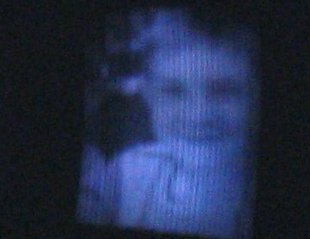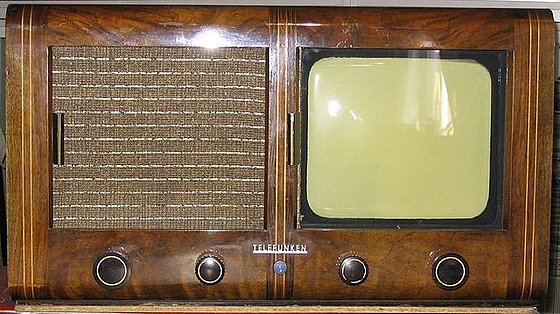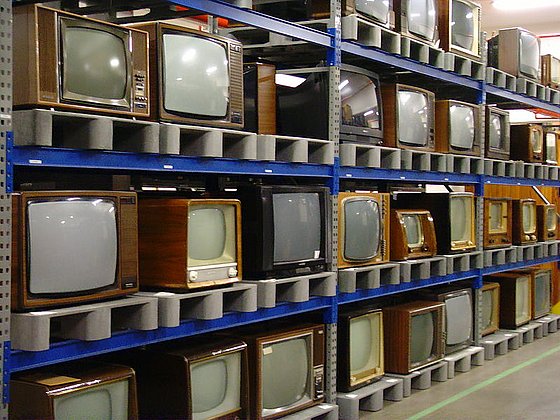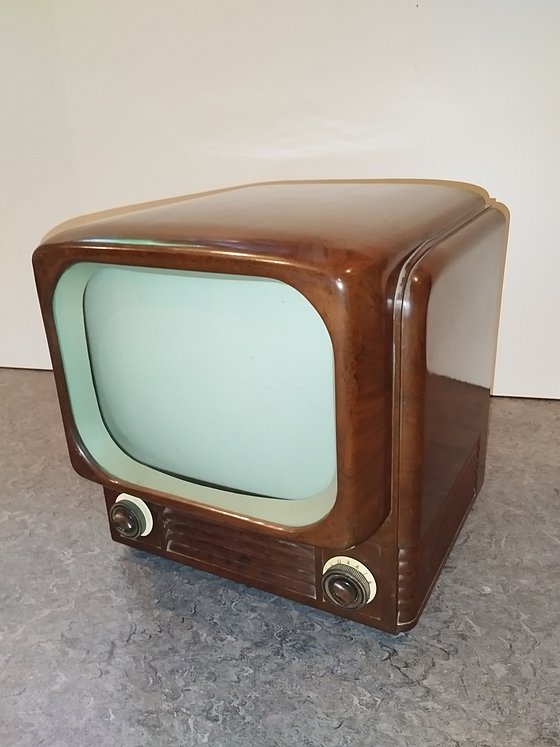
The invention of the black and white television
Prof Dr Dieter Brückmann/ Communications Engineering
Photo: UniService Transfer
The transmission of moving images
The engineer Dieter Brückmann on the invention of the black-and-white television set
The idea of the black-and-white television began as early as 1884 with the invention of a spiral perforated disc. What was it all about?
Brückmann: After the transmission of speech and music became possible with the help of the telephone in the 19th century, there were already initial considerations about transmitting images with the help of electrical signals. It very quickly became clear that for a technical realisation, the corresponding image first had to be broken down into smaller and simpler image parts so that it could be converted into electrical signals. The corresponding electrical signals can then be transmitted to the receiver, where they can be reassembled into an image.
The first patent related to the development of television was granted in 1884. Paul Nipkow received this patent for the idea of splitting images into points of light using a rotating disc with holes arranged in a spiral. This allows images to be converted into light-dark signals, which generate corresponding, changing electrical signals with the help of a photocell. In the receiver, these varying signals must be converted into fluctuations in the current intensity, which in turn lead to fluctuations in the brightness of a light bulb controlled by it. Using the same Nipkow disc as on the transmitter side, the original image can then be reassembled from the light signals.

Television picture on the Nipkow disc. The first televisions all used this system.
Photo: Klaus Nahr / CC BY-SA 2.0
The holes in the Nipkow disc are arranged in a spiral so that there is only one hole in front of the image to be transmitted. The rotating movement causes the hole to move over exactly one line of the image in a fixed time interval. The holes are now arranged in such a way that when the current hole has reached the end of the line, the next hole is located at the beginning of the next line. This means that exactly one line of the image is scanned through each hole. After a full rotation of the disc, the entire image has been scanned and the process starts again. With the help of this process, the first television picture transmissions were made at the beginning of the 20th century.
In 1924, the Leipzig physicist and electrical engineer August Karolus acquired a patent for light control in television picture transmission. That was when the first moving images were created, wasn't it?
Brückmann: Among other things, August Karolus made a name for himself with the invention of the "Karolus cell" named after him. This is an inertia-free light modulator that can be used in the reception path of a television to generate the image on a matte screen. The aim of Karolus' work was in particular the development of methods for electro-optical long-distance transmission such as image telegraphy. As early as 1924, he demonstrated a television set-up at the Leipzig Institute of Physics that also enabled the transmission of moving images. In cooperation with the Telefunken company, Karolus used it to realise an image transmission from Berlin to Leipzig in 1925.

In 1939, Telefunken's E1 standard television receiver was the first television set that more people could afford.
Photo: Eckhard Etzold / CCBY-SA 3.0
Four years later, Karolus presented the first unsaleable television at the Funkausstellung in Berlin, but still had a Hungarian competitor, which was initially more successful despite its poorer picture quality. Why?
Brückmann: The Hungarian Denes von Mihály had already presented the first television transmission in Germany with his own receiver in a small circle in Berlin in May 1928, shortly before the radio exhibition. August Karolus then also presented his television system at the 5th Great Radio Exhibition in Berlin. The reception image of this Telefunken prototype had a resolution of around 10,000 pixels and was therefore of a much higher quality than the receiver of the Hungarian competitor, which only had around 900 pixels. Nevertheless, Dénes von Mihály's solution was convincing because it was simpler and cheaper. It met with a much greater response, while Telefunken's prototype was unsaleable. Mihály's solution with the 30-line picture was then also the basis for the first standardisation of television signals.

Collection of televisions in the Museum of Communication.
Photo: Klaus Nahr / CC BY-SA 2.1
At first there was only mechanical television, which was replaced by electronic television in 1931. Can you explain the difference?
Brückmann: At the beginning of a television transmission, the still or moving image must first be broken down into individual points of light, which can then be converted into electrical impulses using a photocell. In mechanical television, this decomposition was often carried out using a Nipkow disc. Other mechanical processes with moving mirrors were also used. The electrical impulses were then transmitted to the receiver via a cable and later also via radio, where they could be reassembled into images with the help of a Nipkow disc running synchronously with the transmitter. The system presented by Denes von Mihaly in 1928, for example, worked with such a Nipkow disc.
In electronic television, on the other hand, the images were broken down by scanning them with the help of a cathode ray in a "Braun tube", which was an essential element of the camera. On the receiving end, the transmitted electrical information was converted into a cathode ray and projected line by line in a screen tube in the form of light pulses. The afterglow of the dots on the screen produced a uniform image. Due to the high demands on the speed of image scanning and reproduction, it was not until the early 1930s that a fully electronic realisation of television became possible. Manfred von Ardenne in particular made important contributions to this with the successful realisation of fully electronic scanning and reproduction using the Braun tube. He presented fully electronic television to the public for the first time at the Radio Exhibition in 1931. Electronic television offered far better opportunities to improve picture resolution and picture quality and therefore became established over time.
The first television station went on air in Berlin in 1935. There was an hour and a half programme every evening. However, the picture quality was not good and the set was too expensive. You can't call it a mass medium yet, can you?
Brückmann : Germany was the first country to have a regular television programme from 1935 to 1944. In 1936, there were broadcasts of the Olympic Games in Berlin. Television began in Great Britain in 1936 and in the USA in 1937/38.
Even though this was the "first regular television programme service in the world" to go into operation in Germany, it was still a long way from being a mass medium. Even in Berlin and the surrounding area, there were only around 250 television receivers. At that time, the industry was not yet able to mass-produce television receivers. In order to promote interest and distribution, the Deutsche Reichspost (DRP) opened the first public television reception point for community reception on 9 April 1935. Only a short time later, further television parlours and large-screen stations were set up. Here, up to 30 people could watch television together free of charge. However, at 18 cm × 22 cm, the picture was very small and also lacked contrast and flickered. The devices were not yet technically mature and were too expensive. As a result, interest among viewers was rather restrained, as the cinema already offered far better picture quality.

Television set TV 62
Design ca. 1948, production ca. 1950
Bush, England / Bakelite, pressed cardboard
Exhibit from the Schriefers design collection
Photo: Stephan Ohnjec
The age of high-definition television began in the UK in 1936. What did that mean?
Brückmann: What was understood by high-definition television at that time is not comparable with the high-definition television of our time, which is standardised in the HDTV norms. While the system that went into operation in Germany in 1936 initially only worked with 30 lines, the high-definition television introduced in Great Britain in 1936 broadcast with a much larger number of lines. Initially in trial operation, a system with 240 lines and a Marconi system with 405 lines were broadcast alternately on a weekly basis. In February 1937, a standard of 405 lines and 25 frames per second was agreed, with an aspect ratio of 5:4. This standard remained in place in the UK until 1965, with only the aspect ratio being adjusted to 4:3 in 1950.
In Germany, too, the standard for television was adapted to technical developments and set at 441 lines with a frame rate of 25 Hz in 1937. In addition, the so-called interlaced scanning method was introduced, in which 50 fields per second are transmitted. This significantly reduced the impression of disturbing flickering caused by the low frame rate of 25 Hz. With the interlaced scanning method, only every second line is transmitted per field, first all odd-numbered lines and then all even-numbered lines. It is still used today, except for some HDTV processes.
After the Second World War, television began its triumphant advance into German living rooms and colour television was introduced in 1967. How did you get the colours onto the screen?
Brückmann: The official launch of colour television in the Federal Republic of Germany took place at the 1967 Funkausstellung with the pressing of the red button by the then Foreign Minister Willi Brandt. However, the button was only a dummy, the actual switchover was carried out by a technician in the background, who was a little too fast, so that the colours appeared on the screen before the button was pressed. In retrospect, this mishap was explained by the fact that it was a particularly fast switch. As only a few viewers had a colour television at the time, this incident caused little sensation. This would certainly be different today.
The principle of colour television is based on using the camera and suitable colour filters to first split the colour image into its primary colours red, green and blue. For each individual pixel, the information about the intensity of the corresponding three colour components and additional brightness information is converted into electrical signals and transmitted electronically to the receiver. At the receiving end, these signals are used to control the picture tube, which generates three different electron beams for the three primary colours. These electron beams are aligned with a perforated mask behind which the screen is located. The screen in turn contains a large number of picture elements, all of which are made up of groups of three dots or rods that light up in red, green and blue. Through additive colour mixing, a pixel appears to the viewer in its original colour. As a typical screen is made up of at least one million pixels, the viewer sees an apparently clear and colourful image at a certain distance. Since only the brightness information can be extracted from the transmitted signal, the colour signals could also be received and evaluated with black and white televisions.
An important step towards the introduction of colour television was the development of a standard that was as uniform as possible. In America and Japan, the NTSC system was already introduced as a standard in the 1950s. From a European perspective, however, the colour images produced with this system had too many quality problems, the colours were sometimes unnatural and not very stable.
An important step towards the introduction of a colour television standard for Europe was the use of a uniform line standard. As early as 1948, a standard with 625 lines had been agreed upon, which was then implemented as the European broadcasting standard. Under the leadership of the German engineer Walter Bruch, the PAL standard was developed in the 1960s, which is the leading standard in Europe today and which enabled a far more natural colour image generation without colour distortion. At the same time, a separate solution called SECAM was developed in France, a slightly different standard which, however, did not gain widespread acceptance. In addition to France, the countries of the former Eastern Bloc in particular used SECAM. One disadvantage of SECAM systems compared to the PAL system is the lack of quality in colour image generation.
Where is black and white technology still used today?
Brückmann: Black and white televisions were produced until the 2000s, as they were still valued by viewers as an inexpensive alternative or as a portable, simple second set. Today, image or video transmissions in black and white are still primarily used as a cost-effective solution for video surveillance. However, black and white televisions in the true sense of the word are hardly used in Germany today.
However, black and white technology still plays a role as an artistic stylistic device. Some directors, such as Edgar Reitz, deliberately shoot films using this technique. He sees the renunciation of colour as a reduction to the essentials. Incidentally, this was one of the reasons why German television stations deliberately refrained from using colour in news broadcasts for several years after the introduction of colour television.
Uwe Blass
Prof Dr Dieter Brückmann is head of the Department of Communications Engineering, Components and Circuit Technology in the Faculty of Electrical Engineering, Media Technology and Information Technology at the University of Wuppertal.
